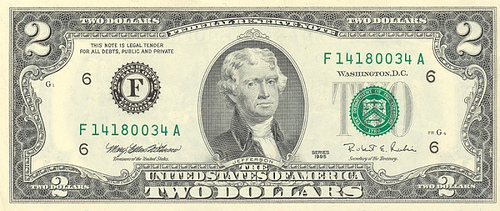 Just last week, I took a trip back to my hometown of New Haven, and I retold this story to a mutual friend of ours at a local bar. We were both equally puzzled about this strange occurrence. I have never in my life been in possession of a two-dollar bill, and we both thought perhaps that Baltimore was such a backwards place that the bills had never fallen out of use. The bartender overheard us and said that he had two in his pocket that he had received from customers that week.
Just last week, I took a trip back to my hometown of New Haven, and I retold this story to a mutual friend of ours at a local bar. We were both equally puzzled about this strange occurrence. I have never in my life been in possession of a two-dollar bill, and we both thought perhaps that Baltimore was such a backwards place that the bills had never fallen out of use. The bartender overheard us and said that he had two in his pocket that he had received from customers that week."It's the recession," he said simply. His theory was that when economic times are tough, people start dipping into any reserves of cash they might have on hand, whether those be collectible coins, loose change in the couch, or a stash of two-dollar bills.
The two-dollar bill has actually never been pulled from circulation. They currently make up roughly 1% of the money supply, and the Federal Reserve continues to print the bill. According to the Fed, "The $2 bill has not been removed from circulation and is still a circulating denomination of United States paper currency. The Federal Reserve System does not, however, request the printing of that denomination as often as the others. The Series 2003 $2 bill was the last printed and bears the names of former Secretary of the Treasury John W. Snow and Treasurer Rosario Marin. As of April 30, 2007 there were $1,549,052,714 worth of $2 bills in circulation worldwide."
Most of the bills, however, are not in regular circulation. Banks hold on to them and usually only distribute them to customers when they are specifically requested. Most of them end up, for example, stashed away in the pockets of bartenders instead of in the register to be given out in the normal course of transactions.
Perhaps the cab drivers of Baltimore are simply following the orders of the Federal Reserve to use the bills like you would any other currency, and our neighborhood bartender just happened to get lucky. I have not found any evidence or research about links between the resurfacing of two-dollar bills and recessions, but it seems to make logical sense.
For the past several years, the two-dollar bill has started to become more and more common. A Reuters story from 2006 reports increased orders for the bills from banks since 2001, though it is hard to say why. The piece cites the bills' popularity among strip clubs, as they mean double the tips for the dancers. It is possible that the combination of increased supply and less reluctance on the part of spenders to use them due to the recession has led to their increased visibility.

The bill has been linked to the current recession, but in a different way. Recently a story appeared in several news outlets about a pharmacy owner in Alabama who earlier this year gave his employees his own economic stimulus. Danny Cottrell gave each of his full-time employees bonuses of $700 and his part-time staff $300, with two conditions: they had to give 15% of the cash to charity, and the remainder had to be spent in local businesses. To track his employees' spending, he handed out the bonuses entirely in two-dollar bills, so that if they did as they were told, the local market would be flooded with the bills (A similar scheme was tried by the Geneva Steel Company in Utah in 1989 to show the economic importance of the company and its employees. The bills have subsequently been used to show the impacts of the plant's closing in 2001.) Interestingly, Mr. Cottrell also wrote an article in 2004 for VFW Magazine about a limited-time release of uncirculated two-dollar bills from the Federal Reserve. Perhaps that is how he managed to get ahold of $16,000 worth of the bills to dole out to his employees.
Is the two-dollar bill really an indicator of the recession? It is hard to tell. I think we will only know how bad things really are when people start paying for their beers and cab rides with their own gold teeth.




Maybe your friend is lying, and instead of going to a "family wedding," he was actually working as a dirty Baltimore stripper.
ReplyDeleteEntirely possible.
ReplyDeleteTwo dollar bills are awesome! I spend them all the time because they usually make cashiers smile during an otherwise dull shift.
ReplyDeleteYes, $2 bills are suppose to be pretty popular in the strip joints. But I like spending them as well, since they always seems to "wake people up" when I spend them. And a few people will actually think they are worth something more than $2, and will save them out of the till - Ha. And then you will get a few cashiers that will use those pens to check if they are fake. Oh, and I usually put an order for at least $800 at a time at my bank.
ReplyDeleteDan